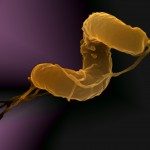Lien vers Pubmed [PMID] – 39018459
Lien DOI – 10.1146/annurev-micro-041522-094053
Annu Rev Microbiol 2024 Nov; 78(1): 233-253
Peptidoglycan (PGN) and associated surface structures such as secondary polymers and capsules have a central role in the physiology of bacteria. The exoskeletal PGN heteropolymer is the major determinant of cell shape and allows bacteria to withstand cytoplasmic turgor pressure. Thus, its assembly, expansion, and remodeling during cell growth and division need to be highly regulated to avoid compromising cell survival. Similarly, regulation of the assembly impacts bacterial cell shape; distinct shapes enhance fitness in different ecological niches, such as the host. Because bacterial cell wall components, in particular PGN, are exposed to the environment and unique to bacteria, these have been coopted during evolution by eukaryotes to detect bacteria. Furthermore, the essential role of the cell wall in bacterial survival has made PGN an important signaling molecule in the dialog between host and microbes and a target of many host responses. Millions of years of coevolution have resulted in a pivotal role for PGN fragments in shaping host physiology and in establishing a long-lasting symbiosis between microbes and the host. Thus, perturbations of this dialog can lead to pathologies such as chronic inflammatory diseases. Similarly, pathogens have devised sophisticated strategies to manipulate the system to enhance their survival and growth.


